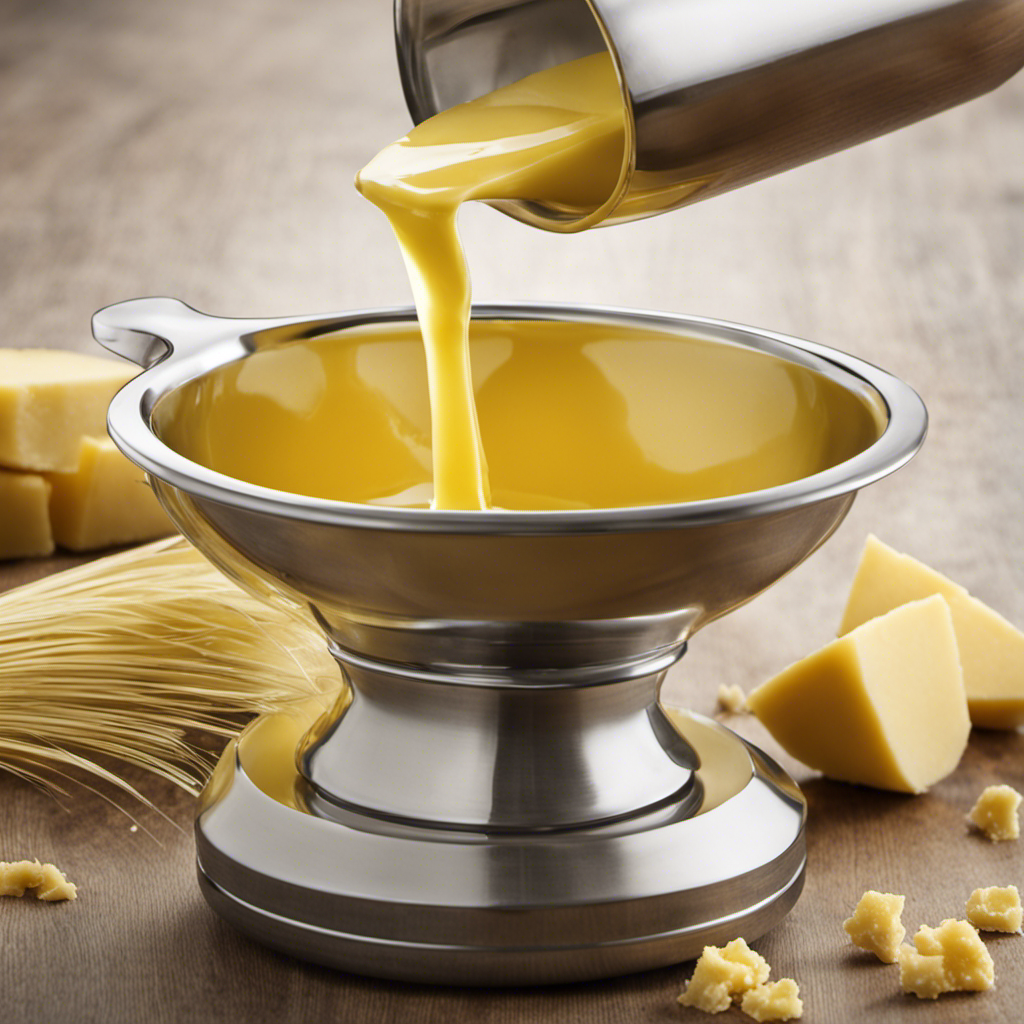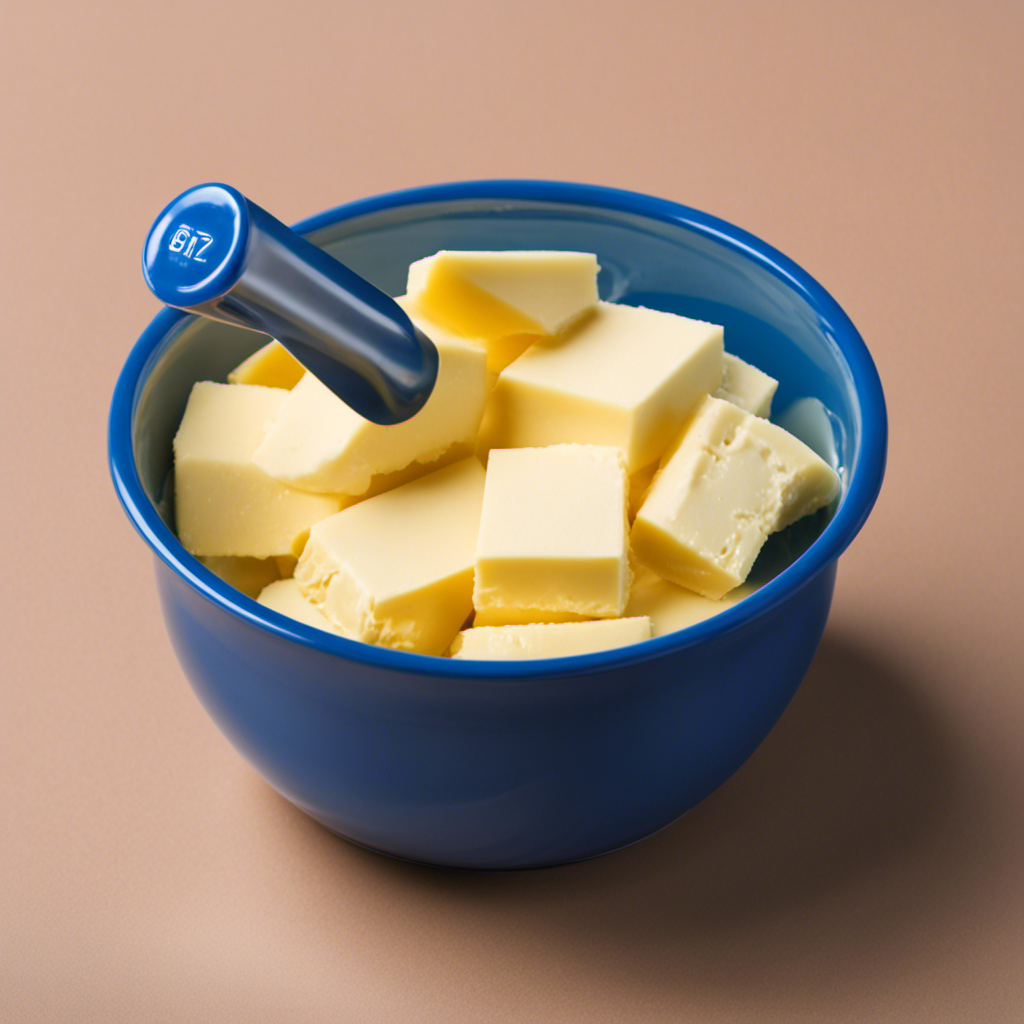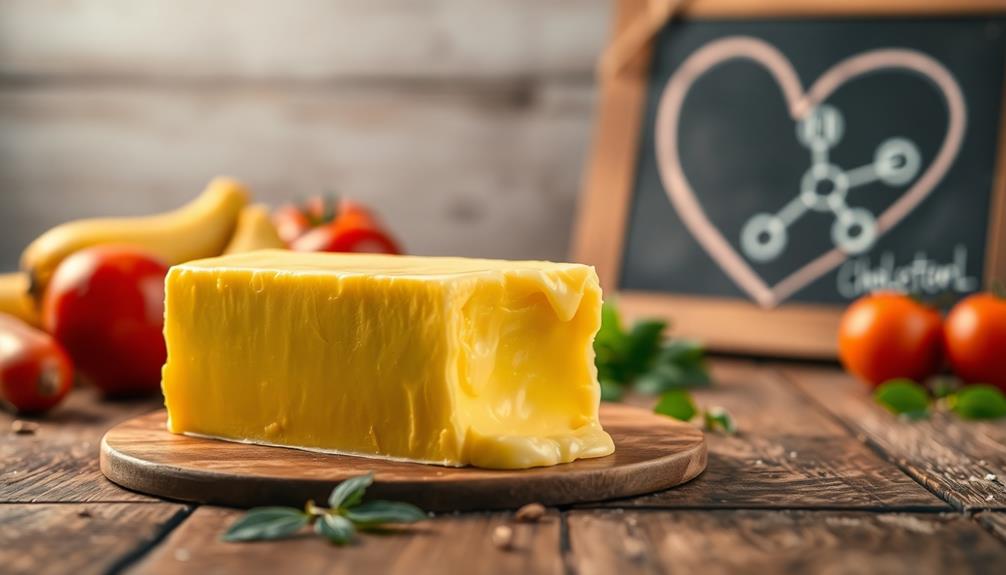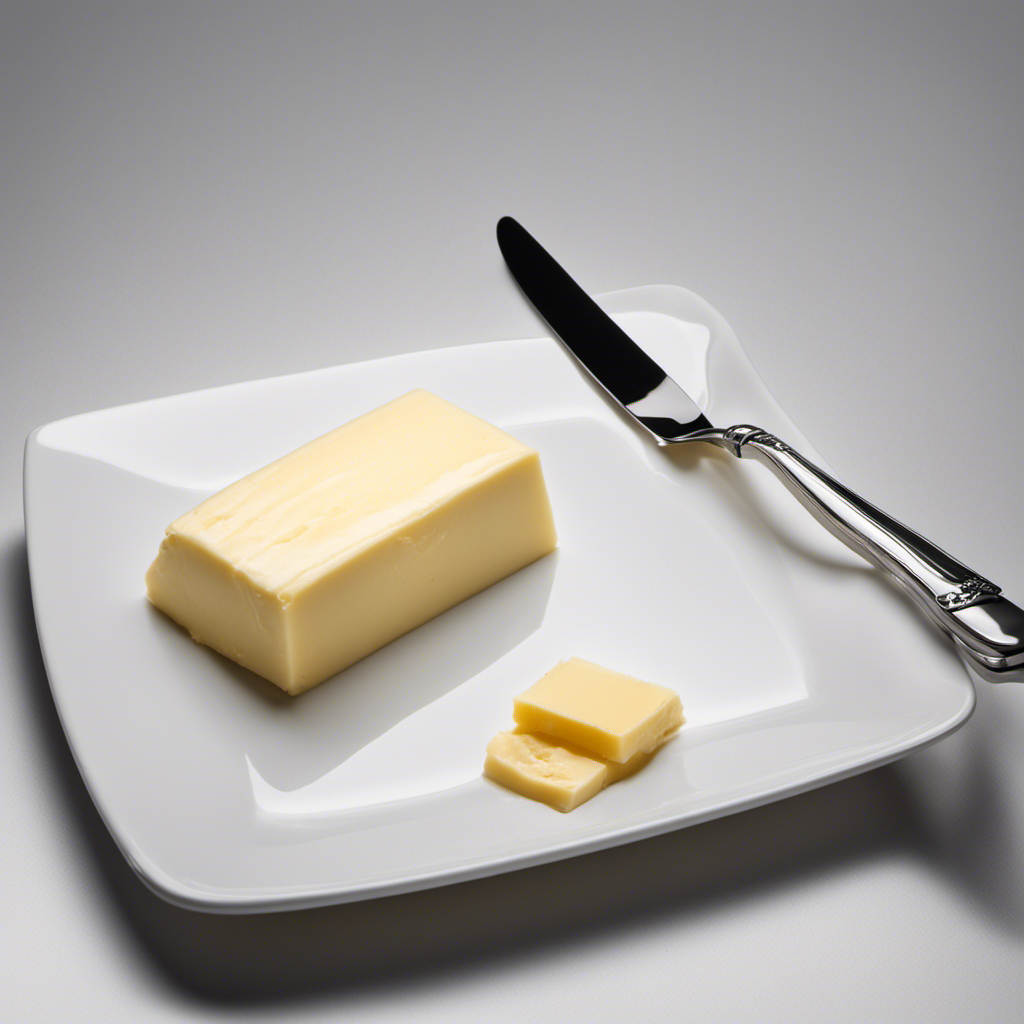As someone who bakes at home, I frequently encounter a challenge: figuring out how many tablespoons are in a stick of butter. This question, which appears straightforward, can be perplexing and result in imprecise measurements in our cherished recipes.
In this article, I will delve into the history of the stick of butter measurement, provide a straightforward conversion to tablespoons, and discuss the importance of accurate measurements in baking.
So, let’s roll up our sleeves and uncover the secrets to perfectly measured butter!
Key Takeaways
- The standard size for a stick of butter is 1/2 cup or 8 tablespoons.
- One stick of butter is equal to 8 tablespoons or 1/2 cup.
- Precise measuring tools like tablespoons or kitchen scales are recommended for accurate measurements.
- Stick of butter is commonly used in various recipes such as chocolate chip cookies, brownies, pancakes, mashed potatoes, buttercream frosting, and sautéed vegetables.
History of the Stick of Butter Measurement
Did you know that the stick of butter measurement was introduced in the early 20th century?
The history of the stick of butter measurement dates back to the early 1900s when pre-packaged butter became popular in the United States. Before that, butter was typically sold in bulk and measured by weight. However, with the rise of convenience and standardization, the idea of packaging butter in stick form was born.
The standard size for a stick of butter is 1/2 cup or 8 tablespoons. This measurement made it easier for consumers to know exactly how much butter they were using in recipes. Today, the stick of butter measurement is widely recognized and used in the United States, simplifying butter measurement conversions in recipes.
Converting Stick of Butter to Tablespoons
To convert a stick of butter to tablespoons, you’ll need to know the measurement equivalence. One stick of butter is equal to 8 tablespoons. This conversion factor is based on the standard size of a stick of butter in the United States, which is typically 1/2 cup or 4 ounces.
Each tablespoon is equivalent to 1/16th of a cup, so 8 tablespoons make up 1/2 cup. It is important to note that this measurement equivalence may vary in different countries, as butter packaging and sizes can differ.
When measuring butter, it’s always a good idea to use a precise measuring tool, such as a tablespoon or kitchen scale, for accurate results. This ensures the right amount of butter is added to your recipes, guaranteeing the desired taste and texture.
Importance of Accurate Measurements in Baking
Precision in baking is crucial for achieving consistent and delicious results. Accurate measurements play a key role in ensuring that each ingredient is added in the right amount, allowing for the perfect balance of flavors and textures.
Precision in Baking
When baking, it’s important to be precise with measurements. Precision in measurements ensures that the recipe turns out as intended and that the flavors and textures are balanced.
One common mistake in measuring butter is not using the correct conversion. A stick of butter is equal to 8 tablespoons or 1/2 cup. However, if you don’t have a stick of butter on hand, it’s crucial to measure it accurately using a kitchen scale.
Another mistake is not softening the butter to the right consistency before using it in the recipe. Softened butter should be pliable but not melted.
Consistency Through Measurements
Measuring ingredients accurately is essential for achieving consistent results in your baked goods. When it comes to baking, precision is key.
One area where accuracy is particularly important is in measuring butter. In the past, butter was usually sold in blocks or wrapped in paper, making it difficult to measure accurately. However, with the advent of standardized measurements, the packaging of butter has evolved. Nowadays, butter is commonly sold in sticks, with each stick typically equivalent to 1/2 cup or 8 tablespoons.
This uniform packaging has made it much easier for bakers to measure the right amount of butter for their recipes. By using standardized measurements, you can ensure that your baked goods turn out consistently delicious every time.
Common Recipes Using a Stick of Butter
If you’re making chocolate chip cookies, a stick of butter is usually the perfect amount to use. It’s a common measurement in many recipes that require butter. But what about other recipes? How does a stick of butter fit into those? Let’s take a look at some common recipes that use a stick of butter as a measurement:
| Recipe | Stick of Butter (8 tbsp) |
|---|---|
| Brownies | 1 stick |
| Pancakes | 1 stick |
| Mashed Potatoes | 1 stick |
| Buttercream Frosting | 2 sticks |
| Sautéed Vegetables | 1/2 stick |
These recipes showcase the versatility of a stick of butter. From sweet treats like brownies and pancakes to savory dishes like mashed potatoes and sautéed vegetables, a stick of butter can add that rich and creamy flavor. So next time you’re using a recipe that calls for butter, reach for a stick and you’ll be on your way to deliciousness.
Alternative Measurements for Butter in Cooking
When it comes to cooking with butter, there are a few key points to keep in mind.
First, butter conversion charts can be incredibly helpful when trying to figure out how much butter to use in a recipe. These charts provide measurements in both weight and volume, allowing you to easily convert between the two.
Additionally, it’s important to consider butter substitutes for those who are looking for healthier options or have dietary restrictions.
Understanding these different aspects of cooking with butter can greatly enhance your culinary skills.
Butter Conversion Charts
To find out how many tablespoons are in a stick of butter, you can refer to butter conversion charts. These charts provide butter measurement equivalents and can be a handy tool in the kitchen.
One stick of butter is equal to 8 tablespoons or 1/2 cup. This information is useful when following a recipe that specifies butter in tablespoons rather than sticks.
It’s important to note that butter conversion can vary depending on the brand or type of butter. Some brands may have slightly different measurements, so it’s always a good idea to double-check the conversion chart provided by the specific brand.
Weight Vs Volume
When it comes to measuring ingredients, there are two common methods: weight and volume. Understanding the difference between the two is important, especially when converting butter measurements.
-
Weight: This method measures the actual mass of an ingredient, typically in ounces or grams. It provides a more accurate measurement since it accounts for any variations in density or moisture content.
-
Volume: This method measures the space occupied by an ingredient, usually in tablespoons or cups. It is more convenient when using measuring cups or spoons, but it may not be as precise as weight measurements.
To convert butter measurements, it’s essential to know the weight-to-volume ratio. For example, one stick of butter weighs 4 ounces or 113 grams, which is equivalent to 8 tablespoons. By understanding this ratio, you can easily convert recipes that use different units of measurement.
Butter Substitutes
If you’re looking for alternatives to butter, there are several options you can consider. Butter substitutes can be a great choice for those who are lactose intolerant or following a vegan diet. Here are a few options to consider:
| Butter Substitute | Alternative Measurement |
|---|---|
| Coconut oil | 1:1 |
| Olive oil | 3/4 cup |
| Avocado | 1:1 |
Coconut oil is a popular choice as it has a similar texture and flavor to butter. It can be used in a 1:1 ratio, meaning you can substitute it for butter in equal amounts. Olive oil is another option, and you can use 3/4 cup of olive oil for every 1 cup of butter called for in a recipe. Avocado can also be used as a butter substitute in a 1:1 ratio. These alternatives provide a healthier option while still maintaining the desired texture and taste in your recipes.
Tips for Properly Measuring Butter Stick to Tablespoons
Measuring butter sticks to tablespoons can be tricky, but there are tips for doing it properly. As someone who loves cooking, I’ve learned a few tricks that help me measure butter accurately for non-baking recipes. Here are three helpful tips to keep in mind:
-
Softened Butter: When a recipe calls for a specific number of tablespoons, make sure your butter is softened. This will ensure smooth and accurate measurements.
-
Converting Grams: If you have a recipe that uses grams instead of tablespoons, you can easily convert it. One stick of butter is equal to 113 grams or approximately 8 tablespoons.
-
Pack it In: When measuring butter, remember to pack it into the tablespoon. Use the back of a knife or a spatula to press the butter firmly into the spoon, removing any air pockets.
Frequently Asked Questions
What Is the Nutritional Value of a Stick of Butter?
The nutritional value of a stick of butter includes high amounts of saturated fat and cholesterol. However, it can add richness and flavor to dishes. Some cooking alternatives include using olive oil or mashed avocado.
Can I Use Margarine Instead of Butter in Recipes That Call for a Stick of Butter?
Yes, you can use margarine instead of butter in recipes that call for a stick of butter. However, keep in mind that margarine has a higher water content, which may affect the texture and flavor of your baked goods.
How Long Does a Stick of Butter Typically Last in the Refrigerator?
I typically store butter in the refrigerator to keep it fresh. To determine if butter has gone bad, I check for any changes in smell, texture, or appearance. Proper storage and regular checks help ensure its quality.
Are There Any Health Concerns Associated With Consuming a Stick of Butter?
There are potential health risks associated with consuming a stick of butter. It is high in saturated fat, which can increase the risk of heart disease. Consider healthier alternatives like olive oil or avocado.
Can I Substitute Oil for a Stick of Butter in Recipes?
Yes, you can substitute oil for a stick of butter in recipes. There are several alternatives to butter in baking, such as vegetable oil or coconut oil. It’s important to consider the flavor and texture changes it may cause.
Conclusion
In conclusion, understanding the measurement of a stick of butter in tablespoons is crucial for accurate baking. It allows for precise and consistent results in recipes.
Interestingly, did you know that a stick of butter is equivalent to 8 tablespoons? This statistic highlights the importance of knowing this conversion, as it can greatly impact the final outcome of your baked goods.
So, next time you’re in the kitchen, remember to measure your butter properly to ensure delicious results.










